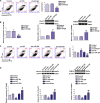Mechanism of Snhg8/miR-384/Hoxa13/FAM3A axis regulating neuronal apoptosis in ischemic mice model
- PMID: 31165722
- PMCID: PMC6549185
- DOI: 10.1038/s41419-019-1631-0
Mechanism of Snhg8/miR-384/Hoxa13/FAM3A axis regulating neuronal apoptosis in ischemic mice model
Erratum in
-
Correction: Mechanism of Snhg8/miR-384/Hoxa13/FAM3A axis regulating neuronal apoptosis in ischemic mice model.Cell Death Dis. 2019 Aug 21;10(9):632. doi: 10.1038/s41419-019-1865-x. Cell Death Dis. 2019. PMID: 31434870 Free PMC article.
Abstract
Long noncoding RNAs, a subgroup of noncoding RNAs, are implicated in ischemic brain injury. The expression levels of Snhg8, miR-384, Hoxa13, and FAM3A were measured in chronic cerebral ischemia-induced HT22 cells and hippocampal tissues. The role of the Snhg8/miR-384/Hoxa13/FAM3A axis was evaluated in chronic cerebral ischemia models in vivo and in vitro. In this study, we found that Snhg8 and Hoxa13 were downregulated, while miR-384 was upregulated in chronic cerebral ischemia-induced HT22 cells and hippocampal tissues. Overexpression of Snhg8 and Hoxa13, and silencing of miR-384, all inhibited chronic cerebral ischemia-induced apoptosis of HT22 cells. Moreover, Snhg8 bound to miR-384 in a sequence-dependent manner and there was a reciprocal repression between Snhg8 and miR-384. Besides, overexpression of miR-384 impaired Hoxa13 expression by targeting its 3'UTR and regulated chronic cerebral ischemia-induced neuronal apoptosis. Hoxa13 bound to the promoter of FAM3A and enhanced its promotor activity, which regulated chronic cerebral ischemia-induced neuronal apoptosis. Remarkably, the in vivo experiments demonstrated that Snhg8 overexpression combined with miR-384 knockdown led to an anti-apoptosis effect. These results reveal that the Snhg8/miR-384/Hoxa13/FAM3A axis plays a critical role in the regulation of chronic cerebral ischemia-induced neuronal apoptosis.
Conflict of interest statement
The authors declare that they have no conflict of interest.
Figures






Similar articles
-
A review on the role of SNHG8 in human disorders.Pathol Res Pract. 2023 May;245:154458. doi: 10.1016/j.prp.2023.154458. Epub 2023 Apr 7. Pathol Res Pract. 2023. PMID: 37043963 Review.
-
Downregulated long noncoding RNA LUCAT1 inhibited proliferation and promoted apoptosis of cardiomyocyte via miR-612/HOXA13 pathway in chronic heart failure.Eur Rev Med Pharmacol Sci. 2020 Jan;24(1):385-395. doi: 10.26355/eurrev_202001_19937. Eur Rev Med Pharmacol Sci. 2020. PMID: 31957853
-
Dexmedetomidine had neuroprotective effects on hippocampal neuronal cells via targeting lncRNA SHNG16 mediated microRNA-10b-5p/BDNF axis.Mol Cell Biochem. 2020 Jun;469(1-2):41-51. doi: 10.1007/s11010-020-03726-6. Epub 2020 Apr 22. Mol Cell Biochem. 2020. PMID: 32323054 Free PMC article.
-
LncRNA Snhg8 attenuates microglial inflammation response and blood-brain barrier damage in ischemic stroke through regulating miR-425-5p mediated SIRT1/NF-κB signaling.J Biochem Mol Toxicol. 2021 May;35(5):e22724. doi: 10.1002/jbt.22724. Epub 2021 Jan 25. J Biochem Mol Toxicol. 2021. PMID: 33491845
-
Long non-coding RNA MEG3 functions as a competing endogenous RNA to regulate ischemic neuronal death by targeting miR-21/PDCD4 signaling pathway.Cell Death Dis. 2017 Dec 13;8(12):3211. doi: 10.1038/s41419-017-0047-y. Cell Death Dis. 2017. PMID: 29238035 Free PMC article.
Cited by
-
Long non-coding RNA small nucleolar RNA host gene 8 (SNHG8) sponges miR-34b-5p to prevent sepsis-induced cardiac dysfunction and inflammation and serves as a diagnostic biomarker.Arch Med Sci. 2024 Aug 22;20(4):1268-1280. doi: 10.5114/aoms/175468. eCollection 2024. Arch Med Sci. 2024. PMID: 39439678 Free PMC article.
-
Identification of New Potential LncRNA Biomarkers in Hirschsprung Disease.Int J Mol Sci. 2020 Aug 2;21(15):5534. doi: 10.3390/ijms21155534. Int J Mol Sci. 2020. PMID: 32748823 Free PMC article.
-
FAM3A mediates the phenotypic switch of human aortic smooth muscle cells stimulated with oxidised low-density lipoprotein by influencing the PI3K-AKT pathway.In Vitro Cell Dev Biol Anim. 2023 Jun;59(6):431-442. doi: 10.1007/s11626-023-00775-1. Epub 2023 Jul 20. In Vitro Cell Dev Biol Anim. 2023. PMID: 37474885
-
FAM3A plays a key role in protecting against tubular cell pyroptosis and acute kidney injury.Redox Biol. 2024 Aug;74:103225. doi: 10.1016/j.redox.2024.103225. Epub 2024 Jun 8. Redox Biol. 2024. PMID: 38875957 Free PMC article.
-
Irisin protects against cerebral ischemia reperfusion injury in a SIRT3-dependent manner.Front Pharmacol. 2025 Apr 1;16:1558457. doi: 10.3389/fphar.2025.1558457. eCollection 2025. Front Pharmacol. 2025. PMID: 40235548 Free PMC article.
References
Publication types
MeSH terms
Substances
LinkOut - more resources
Full Text Sources

